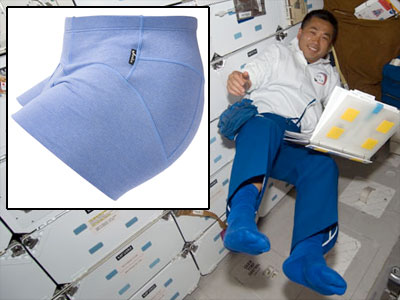|
|

|
|
Author
|
Topic: Japanese J-Ware space underwear, apparel
|
Robert Pearlman
Editor Posts: 42981
From: Houston, TX
Registered: Nov 1999
|
 posted 02-20-2010 09:58 PM
posted 02-20-2010 09:58 PM
   
From the collectSPACE Today in Space History blog: Space underpants sell, won't smellAfter being tested in flight by Japanese astronaut Koichi Wakata while he resided onboard the International Space Station last year, sales began in Japan on February 20 of a new high-tech set of underwear developed to withstand the challenges of long-duration (read: two months) spaceflight. The "J-Ware" boxers were devised by textile experts at Japan Women's University in Tokyo to forego having to be washed (there's no laundromat in space) and still remain odor-free (for the sake of the crew) given their ability to kill bacteria, absorb water, insulate the body and dry quickly. The retail offer is limited for now to just 100 pairs each of sizes medium and large with a price tag per pair of 10,500 yen or about $115.

Koichi Wakata models J-Ware socks. Credit: NASA. Inset: J-Space/JAXAThe J-Ware space underwear is being offered through the J-Space webshop. The blue boxers were first tested in space by Japan Aerospace Exploration Agency (JAXA) astronaut Takao Doi aboard space shuttle mission STS-119 in March 2009, followed by Koichi Wakata who worked aboard the International Space Station for nearly 140 days. Before his return to Earth in July 2009, Wakata commented on the undergarments. "I wore it for about a month and my station crewmembers never complained for that month, so I think the experiment went fine." The J-Ware apparel was developed under JAXA's Aerospace Open Lab Program, a technology transfer effort designed to facilitate the creation of spin-off projects. Development of clothing for astronauts aboard spacecraftThis research is run by the "Near-Future Space-Living Unit" group led by Prof. Yoshiko Taya of Japan Women's University. The goal of this research group is to develop crew cabin clothing that meets the safety requirements for spaceflight, and that ensures the following functions: - Thermal comfort
- Cleanliness
- Mobility
- Beautiful clothing contour
- Lightweight and compact design
The group developed clothing materials with the following properties required for crew cabin clothing: - Heat insulation
- Water-absorption
- Quick evaporation
- Antibacterial
- Odor elimination
- Antistatic
- Antifouling
- Soft and comfortable to skin
Non-sewing technology has given the clothing softness and wearable comfort. Cutting technology has improved the way the clothing fits and moves as the crew works in space. The group also developed a hook and loop fastener with fire retardant properties and fabricated with soft touch materials.
The same textile technology has been adapted by Goldwin, Inc. for its commercial line of MaxiFresh Plus undergarments. |
music_space
Member Posts: 1179
From: Canada
Registered: Jul 2001
|
 posted 02-20-2010 11:34 PM
posted 02-20-2010 11:34 PM
   
OK, I'll get one. Now, do I get the medium or the large?On edit: Thirty-seven medium-size remaining... | |
Contact Us | The Source for Space History & Artifacts
Copyright 2020 collectSPACE.com All rights reserved.

Ultimate Bulletin Board 5.47a
|
|

|
 advertisement advertisement

|












